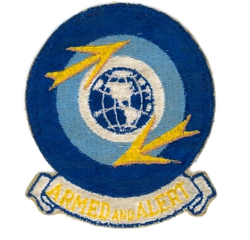| 372nd Bombardment Squadron | |
|---|---|
 B-47 Stratojets on the ramp at Lincoln AFB in 1960 | |
| Active | 1942–1945; 1946–1965 |
| Country | |
| Branch | |
| Role | Bombardment |
| Mottos | Armed and Alert (1959-1965) |
| Engagements | Southwest Pacific Theater Korean War [1] |
| Decorations | Distinguished Unit Citation Philippine Presidential Unit Citation Republic of Korea Presidential Unit Citation [1] |
| Insignia | |
| 372nd Bombardment Squadron emblem [a] [1] |  |
| 372nd Bomb Squadron emblem [b] [2] [3] |  |
The 372nd Bombardment Squadron is an inactive United States Air Force unit. Its last assignment was with the 307th Bombardment Wing at Lincoln Air Force Base, Nebraska, where it was inactivated on 25 March 1965.
Contents
- History
- World War II
- Strategic Air Command
- Lineage
- Assignments
- Stations
- Aircraft
- References
- Notes
- Bibliography
The squadron was first activated in April 1942 as one of the original four squadrons of the 307th Bombardment Group. After training in the United States, it deployed to the Pacific, serving mainly in the Southwest Pacific Theater. The squadron earned two Distinguished Unit Citations for its actions in combat. Following V-J Day, it returned to the United States for inactivation.
The squadron was reactivated as a Strategic Air Command (SAC) bomber squadron in 1946. During the Korean War, it deployed to Okinawa and engaged in combat missions under the control of Far East Air Forces. Following the end of hostilities in Korea, it returned to the United States, converting to Boeing B-47 Stratojets. It flew the Stratojet until it was inactivated in 1965 as that plane was withdrawn from the SAC inventory.
